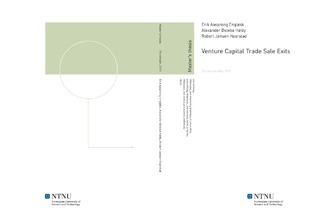Venture Capital Trade Sale Exits
Master thesis
Permanent lenke
http://hdl.handle.net/11250/266030Utgivelsesdato
2011Metadata
Vis full innførselSamlinger
Sammendrag
Even though venture capital trade sale exits are the most common and successful exit vehicle, historically most academic attention has been given to IPO exits. This thesis takes the first steps towards opening the black box that is trade sale exits. The thesis is paper-based, and the main academic contributions belong to the four papers appended. This document opens with an introduction to the field of study as well as overall reflections in order to offer the reader a contextual background. Paper one is based on a literature review, while paper two through four are based on an inductive multiple-case study covering 19 venture capital trade sale exits from Norway and the U.S. Paper one conducts an extensive literature review of venture capital exits in general, leading up to the development of a model denoted The Road to Venture Capital Exit . This model identifies the variables that influence the exit process in the different phases, and describes how these variables influence the exit process.Paper two explores the relation between pre-planned exit strategies and value-adding, and suggests the existence of two different venture capitalist mindsets; the Tailor and the Architect. The Tailor uses exit possibilities as an addition to traditional deal evaluation criteria, has a pre-planned exit strategy, and adds value with exit in mind. The Architect does not use exit possibilities as an evaluation criteria, and adds value in a more general manner.Paper three examines the relationship between the venture capitalist and the entrepreneur during the trade sale exit process, finding that this relationship is characterized more by consensus and cooperation than by conflict and defection. Further, it is found that four factors influence the relationship during the exit process, and are determining for the conflict level. These factors are: pre-investment alignment, strategic hurdles and personal motives faced by the entrepreneur, the reputation and connectedness of the venture capitalist, and the probability for entrepreneurial recycling.Paper four explores the role of financial advisors in trade sale exits, by looking closer at why advisors are utilized, as well as by examining the factors determining the choice of a specific advisor. It is found that advisors are considered especially useful in bargaining situations, through playing the role of bad cops, and also by letting venture capitalists and entrepreneurs focus on their primary tasks. With regards to selection criteria, venture capitalists emphasize industry experience, prior relations and the size of the advisory firm. Finally, the findings are integrated in a framework explaining the role of financial advisors in venture capital trade sale exits.
